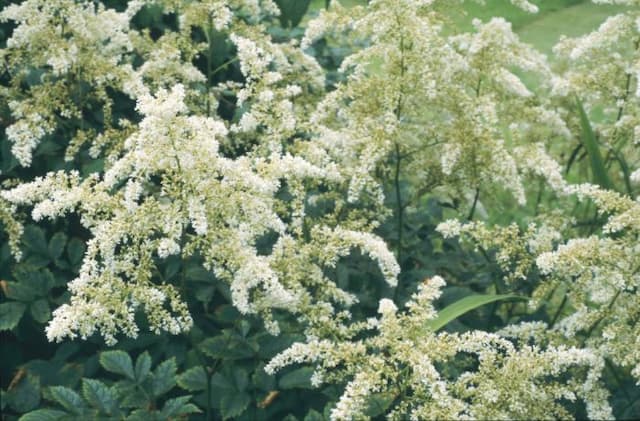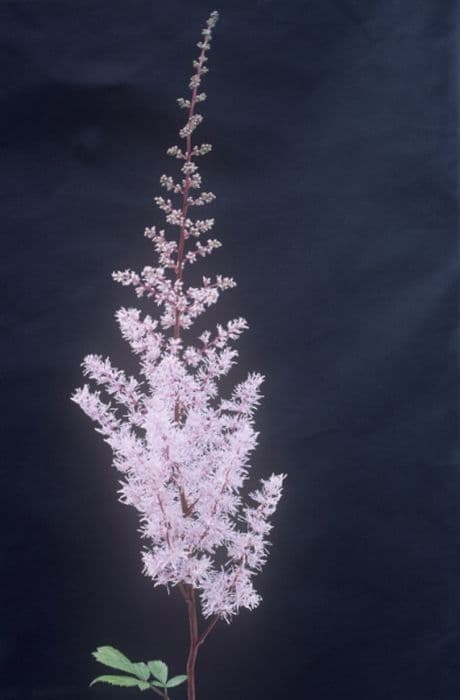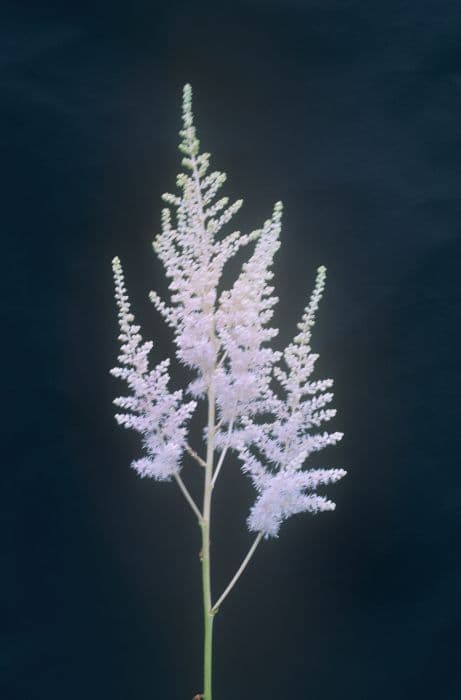Tumbling Waters Saxifrage Saxifraga 'Tumbling Waters' (8)

ABOUT
Saxifraga 'Tumbling Waters' is a delightful plant notable for its cascading habit, making it an excellent choice for rock gardens or as a spillover plant in containers. This variety produces a mound of green, mossy foliage, which is charming in its compact and cushion-like form. The leaves are small and rounded, with a fine, almost velvety texture that is lush and dense. From the center of this green cushion-like foliage, emerge delicate flower stalks that bear clusters of small, star-shaped blooms. The flowers themselves are usually white or pale pink and have a subtle, airy quality about them, creating the illusion of a frothy waterfall. The blossoms may be dotted with contrasting yellow centers that add a tiny spark of color to the overall pastel palette of the plant. The foliage tends to be evergreen, providing year-round interest, with the flowering season usually peaking in the spring to early summer. The visual effect of Saxifraga 'Tumbling Waters' is one of gentle movement and soft texture, offering a sense of serenity and natural beauty to any garden space it graces.
About this plant
 Names
NamesFamily
Saxifragaceae
Synonyms
Tumbling Waters Saxifrage, Waterfall Saxifrage, Cascading Saxifrage
Common names
Saxifraga 'Tumbling Waters'.
 Toxicity
ToxicityTo humans
Saxifraga 'Tumbling Waters', commonly known as saxifrage, is generally considered non-toxic to humans. There is no widespread documentation of toxicity or poisonous effects from ingesting the saxifrage plant. However, it is still advisable for individuals not to consume any part of ornamental plants unless they are known and grown to be edible. If saxifrage is ingested and any adverse reaction occurs, medical attention should be sought.
To pets
Saxifraga 'Tumbling Waters', commonly referred to as saxifrage, is not known to be toxic to pets, including cats and dogs. The ingestion of saxifrage is unlikely to result in poisoning or adverse symptoms. Nevertheless, it is commonly advised to discourage pets from eating plants as a precaution, and to keep an eye on them for any signs of unexpected illness following ingestion. If any such symptoms occur, consulting a veterinarian is recommended.
 Characteristics
CharacteristicsLife cycle
Perennials
Foliage type
Evergreen
Color of leaves
Green
Flower color
White
Height
6 inches (15 cm)
Spread
12 inches (30 cm)
Plant type
Herb
Hardiness zones
5
Native area
Europe
Benefits
 General Benefits
General Benefits- Low Maintenance: Saxifraga 'Tumbling Waters' requires minimal care once established, making it ideal for gardeners of all experience levels.
- Aesthetic Appeal: With its cascading growth and delicate white flowers, it offers visual interest and enhances the beauty of garden spaces.
- Ground Cover: Its tendency to spread makes it an excellent ground cover option, reducing weed growth and covering bare spots.
- Drought Tolerance: Once established, it can tolerate periods of dryness, making it suitable for rock gardens and drought-prone areas.
- Cold Hardy: It is capable of withstanding cold temperatures, making it a robust choice for various climates.
- Attracts Pollinators: The flowers of Saxifraga 'Tumbling Waters' can attract bees and butterflies, promoting biodiversity.
- Soil Erosion Control: Its root system helps to prevent soil erosion on slopes and banks.
 Medical Properties
Medical PropertiesThis plant is not used for medical purposes.
 Air-purifying Qualities
Air-purifying QualitiesThis plant is not specifically known for air purifying qualities.
 Other Uses
Other Uses- Rock gardens: Saxifraga 'Tumbling Waters' is ideal for tucking into crevices or along stone paths where it can cascade beautifully over rocks.
- Container gardening: Its trailing habit makes it a lovely addition to hanging baskets and pots where its foliage and flowers can spill over the edges.
- Ground cover: It can be used to cover bare spots in the garden, spreading quickly to form a dense mat that suppresses weeds.
- Fairy gardens: Due to its small size and delicate appearance, it's perfect for creating whimsical fairy garden landscapes.
- Water features: This plant's preference for moist conditions makes it suitable for planting around ponds or waterfalls where it can thrive with the extra humidity.
- Alpine slides: Gardeners can use Saxifraga 'Tumbling Waters' for alpine slides to mimic its natural mountainous habitat.
- Stepable plant: Its robust nature allows it to be planted between stepping stones, tolerating light foot traffic.
- Photo backdrop: The cascading nature and vibrant blooms provide a picturesque background for photography enthusiasts.
- Winter interest: In mild winter climates, Saxifraga 'Tumbling Waters' may remain evergreen, providing color and texture during the colder months.
- Erosion control: Its spreading habit and root system can help stabilize sloping garden areas prone to erosion.
Interesting Facts
 Feng Shui
Feng ShuiThe Saxifraga is not used in Feng Shui practice.
 Zodiac Sign Compitability
Zodiac Sign CompitabilityThe Saxifraga is not used in astrology practice.
 Plant Symbolism
Plant Symbolism- Perseverance: The name Saxifraga is derived from the Latin words "saxum" (rock) and "frangere" (to break), symbolizing the plant's ability to grow in rocky areas and break through hard surfaces, representing the tenacity to overcome challenges.
- Endurance: Saxifragas, including 'Tumbling Waters', are known for their resilience and longevity, capable of surviving in harsh conditions, making them a symbol of enduring hardships.
- Purity: The delicate white blooms of 'Tumbling Waters' may be seen as a representation of cleanliness and innocence, much like many white flowers symbolize.
- Protection: In some traditions, Saxifragas are believed to ward off evil spirits and are hence planted around homes for protection.
 Water
WaterThe Mossy Saxifrage should be watered when the top inch of soil feels dry to the touch, typically about once a week. It’s important to thoroughly water the plant until excess water drains out of the bottom of the pot, indicating the soil is fully saturated. Allow the water to thoroughly drain, as these plants do not like to be waterlogged. Adjust watering during hotter, drier periods by watering more frequently, and reduce watering during the cooler months. It is typically sufficient to use about 8-16 ounces of water per watering session, depending on the size of the plant and the environmental conditions.
 Light
LightThe Mossy Saxifrage thrives in conditions with bright, indirect light. It can tolerate some morning sun, but it should be protected from the harsh afternoon sun to prevent leaf burn. A spot near a north or east-facing window would provide ideal lighting conditions for this particular plant. Avoid deep shade as this can lead to poor growth and fewer flowers.
 Temperature
TemperatureThe Mossy Saxifrage prefers cool to moderate temperatures, thriving between 60°F and 75°F. It can tolerate a brief period of temperatures as low as 20°F, but prolonged exposure to freezing temperatures can be harmful. To ensure good health and bloom, keep the Mossy Saxifrage away from heat sources and drafts.
 Pruning
PruningPruning Mossy Saxifrage is typically done to remove any dead or damaged foliage and to maintain a compact, attractive shape. It's best to prune after the plant has finished flowering, usually in late spring or early summer. Deadheading spent flowers can encourage a second bloom. Pruning can be done annually or as needed to remove any unsightly leaves.
 Cleaning
CleaningAs needed
 Soil
SoilSaxifraga 'Tumbling Waters', commonly known as Rockfoil or Stonecrop, thrives in well-draining, loamy to sandy soil with a slightly acidic to neutral pH of 5.5 to 7.0. An ideal soil mix would consist of two parts loam, one part sand or perlite, and one part peat or well-rotted compost to retain some moisture while still providing good drainage.
 Repotting
RepottingRockfoil should be repotted every 2 to 3 years to prevent overcrowding and to replenish the soil nutrients. The best time for repotting is during the spring, as the plant emerges from dormancy and is ready for active growth.
 Humidity & Misting
Humidity & MistingRockfoil prefers moderate to high humidity levels, ideally between 50 to 70%. This plant does not thrive in very dry air conditions but is equally intolerant of soggy or damp surroundings, so maintaining a balance is key.
 Suitable locations
Suitable locationsIndoor
Place Rockfoil in a bright spot with some direct light indoors.
Outdoor
Grow Rockfoil outdoors in partial shade with well-draining soil.
Hardiness zone
5-9 USDA
 Life cycle
Life cycleSaxifraga 'Tumbling Waters', commonly known as the Tumbling Waters Saxifrage, begins its life cycle as a seed that germinates in cool, moist conditions, often in the spring. Once the seedling emerges, it develops a rosette of leaves close to the ground, adapted for life in alpine or rocky areas with good drainage. As it enters the vegetative stage, the plant spreads through runners and offsets, forming a dense mat. Throughout the growing season, which is typically in the summer, Tumbling Waters Saxifrage produces tall flowering stalks bearing white, star-shaped flowers that attract pollinators. After pollination, the plant sets seed, which is dispersed by wind, water, or animals, and the parent plant begins to die back as the temperatures decrease in autumn. The plant overwinters with its evergreen foliage, re-emerging the next spring to repeat the cycle.
 Propogation
PropogationPropogation time
Spring-Early Summer
The common propagation method for the Mossy Saxifrage, specifically the 'Tumbling Waters' cultivar, is division. This process is best undertaken in the spring or early fall. Gardeners propagate by carefully lifting the plant and separating the clumps into smaller sections, ensuring each new segment has a piece of the root system attached. These divisions are then planted into well-draining soil at the same depth they were growing previously. For best results, the divisions should be watered adequately until they become established, but care should be taken not to over-water as the Mossy Saxifrage prefers drier conditions. After planting, the young plants generally require a season to establish themselves before blooming prolifically.









